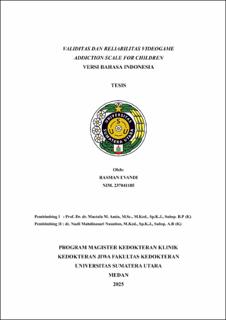Validitas dan Reliabilitas Videogame Addiction Scale for Children versi Bahasa Indonesia
Validity and Reliability of The Indonesian Version of The Videogame Addiction Scale for Children

Date
2025Author
Evandi, Rasman
Advisor(s)
Amin, Mustafa Mahmud
Nasution, Nazli Mahdinasari
Metadata
Show full item recordAbstract
Background: Current technological developments are growing very rapidly and significantly, as
is the development of games that can be accessed online and offline. Online games have quite a lot
of fans, ranging from children, teenagers, to adults. Game players often spend more time playing
games than doing useful activities such as doing assignments, interacting with others, socializing,
or doing work. Indonesia is a country with the third largest game market in the world. Game
addiction has a negative impact on the perpetrators, although there are also positive impacts in
playing games. Indonesia does not yet have a validated instrument in Indonesian to detect
videogame addiction in children. This validated Indonesian version of the Videogame Addiction
Scale for Children (VASC) instrument is expected to be able to detect and prevent the negative
impacts of game addiction in children in Indonesia in general, and North Sumatra in particular.
Method: This research is a methodological study with a quantitative approach, subject selection
using non-probability sampling, cluster sampling type. The sample size was 300 people, to obtain
a valid and reliable Indonesian version of the Videogame Addiction Scale for Children instrument
that can be used and adapted to Indonesian customs and culture. The target population in this study
were elementary school children from grades 3 to 6 aged 8-12 years.
Results: The Indonesian version of the Videogame Addiction Scale for Children (VASC) has
good content validity, namely S-CVI / UA (scale-level content validity index, universal agreement
calculation method) = 21/21 = 1.00. S-CVI /Ave = (1.00 + 1.00 + 1.00 + 1.00 + 1.00) / 5 = 1.00.
Concurrent validity testing was conducted by comparing the Indonesian version of the VASC
score with the Indonesian version of the GAS instrument. The Spearman correlation analysis value
was 0.740, indicating a positive correlation with strong correlation strength. The internal
consistency reliability test of the Indonesian version of the VASC instrument had a reliability
value with a Chronbach's alpha value of 0.884. The corrected item-total correlation (CITC) value
was > 0.3.
Conclusion: The Indonesian version of the VASC instrument is a measuring tool for videogame
addiction in children that has been proven valid and reliable, so it can be used in assessing
videogame addiction in children, and can help in screening efforts or early detection of game
addiction in children in Indonesia.
